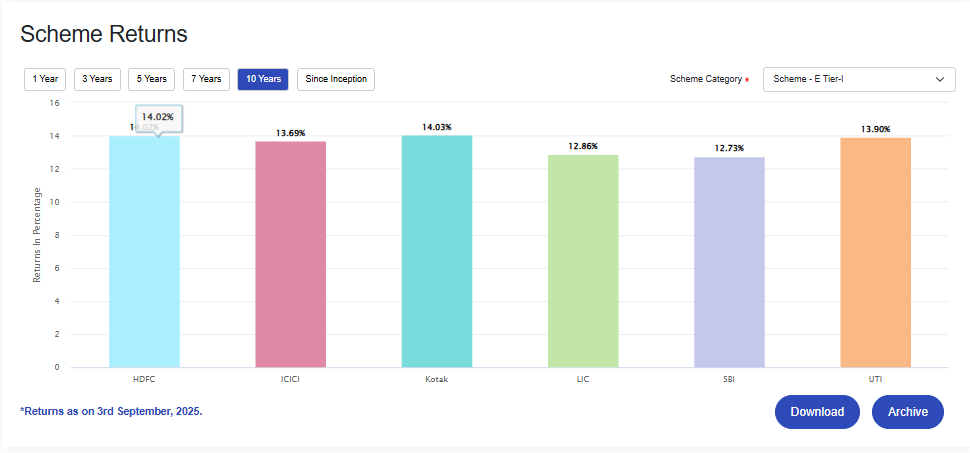NPS Returns: Things You Need to Know
The National Pension System (NPS) is a government-backed retirement savings scheme designed to provide financial security to individuals post-retirement. Launched in 2004, it is a voluntary and portable investment option that allows subscribers to build a pension corpus through regular contributions. NPS is particularly appealing due to its tax benefits, flexibility in investment choices, and the ability to choose from various Pension Fund Managers (PFMs).

What are NPS returns?
NPS returns refer to the Corpus earned on contributions made into the NPS accounts. These returns are derived from investments across various asset classes, such as equities, corporate bonds, government securities, and alternative investment funds. The performance of these underlying assets determines the overall return on investment within the NPS framework.
Why You Should Invest in NPS?
Investing in NPS offers several advantages:
- Retirement Security: It helps build a substantial corpus for retirement, ensuring financial independence.
- Flexibility: Subscribers can choose their PFM and switch between funds as per their changing financial goals.
- Market-Linked Returns: NPS offers market-linked returns based on your investment choices.
- Regulated Framework: Being regulated by the Pension Fund Regulatory and Development Authority (PFRDA), NPS provides transparency and security for investors.
Proven Track Record
*5 years Returns as on 3rd September 2025 under Scheme - E Tier-1

*10 years Returns as on 3rd September 2025 under Scheme - E Tier-1

Types of NPS Investment Options
The NPS contributions made by a subscriber are invested as per the choices (Pension Fund and Asset Allocation) selected and recorded with the Central Recordkeeping Agency (CRA).
- Selection of Pension Funds Subscribers can select any one of the Pension Funds registered with PFRDA. UTI Pension Fund is one of the registered Pension Funds
- Investment Choice for Asset Allocation
Subscriber contributions are invested by the chosen Pension Fund in compliance with PFRDA's investment guidelines across the following Asset Classes:
- Equity (E)
- Corporate Bonds (C)
- Government Securities (G)
- Alternate Assets (A)
Subscribers can select their investment approach via:
- Active Choice
Subscribers actively decide the percentage allocation to each asset class:
- Equity (E): Up to 75%
- Corporate Bonds (C): Up to 100%
- Government Securities (G): Up to 100%
- Alternate Assets (A): Up to 5%
- Auto Choice
Funds are automatically invested in pre-defined proportions across Equity, Corporate Bonds, and Government Securities based on the subscriber's age:
- Allocation remains constant until age 35
- Equity allocation reduces gradually with age
Auto Choice is available through three Life Cycle Funds:
- LC25 ‑ Conservative Life Cycle Fund
- LC50 ‑ Moderate Life Cycle Fund (Default Option)
- LC75 ‑ Aggressive Life Cycle Fund
- BLC ‑ Balanced Life Cycle Fund (Modified LC 50)
Conclusion
The National Pension System presents a compelling opportunity for individuals looking to secure their financial future post-retirement. With its diverse range of investment options—ranging from equities for aggressive growth seekers to government bonds for conservative investors—NPS caters to various risk appetites and financial goals. Understanding the nuances of NPS returns and how different asset classes function can empower subscribers to make informed decisions that align with their retirement objectives. As we move towards a more uncertain economic landscape, investing in NPS could be a prudent choice for ensuring long-term financial stability and peace of mind in retirement.